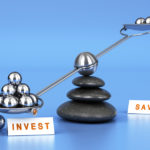What’s the difference between Saving and Investing and how do you move smoothly from the one to the other? Motley Fool Canada has just published the second in a new series of articles by me about the basic steps towards Financial Independence, or what I call “Findependence.” You can find the first one, which ran early in June, here; and the new one by clicking on the highlighted text here: 2 critical steps toward Financial Independence.
The first article discussed how the journey to Findependence hasn’t even begun while you’re still in debt. To paraphrase one of the characters in my book Findependence Day, you can’t even begin to climb the tower of Wealth until you get out of the basement of debt.
It’s nice to be free of debt, whether high-interest credit card debt, student loans or even a mortgage. It’s a big step moving from negative net worth to being merely broke, where your assets and liabilities cancel themselves out. Being free of all debt is certainly a nice place to be if you’ve been anxious over being hounded by creditors. But it’s not financial independence either, which is the stage of life when all sources of income more than meet your monthly financial needs.
As the followup article summarizes, you want to move from Debt elimination to the intermediate step of Saving, and then from Saving to true investing. Saving is being a loaner — you lend money to a bank or other institution and receive a small amount of interest back as well as your principal upon maturity. But to be an investor you want to be an owner: a business owner, through stocks or equities, or more broadly through a diversified basket of equity ETFs.
The end of the piece references a piece by Investopedia about the difference between investing and saving. You can find their explanation here. It says saving is for emergencies and purchases, by which they mean immediate needs. Investing is about a longer-term horizon (defined as seven or more years) and entails more risk than saving. That’s why they refer to the “risk free” return of investing in cash, treasury bills and the like.
Investing is about Money begetting Money
 The beauty about saving is that, once the process is begun, it sets the stage for when money begins to beget still more money, a process that will ultimately happen even while you’re sleeping. So does investing: the difference is that saving is a kind of junior partner to investing: it works a bit for you, but nothing so hard as true investing for the long term. Saving begets small amounts of money; ultimately, investing begets huge amounts of money: eventually enough to live on whether or not you choose to work another day in your life.
The beauty about saving is that, once the process is begun, it sets the stage for when money begins to beget still more money, a process that will ultimately happen even while you’re sleeping. So does investing: the difference is that saving is a kind of junior partner to investing: it works a bit for you, but nothing so hard as true investing for the long term. Saving begets small amounts of money; ultimately, investing begets huge amounts of money: eventually enough to live on whether or not you choose to work another day in your life.
Typically, saving involves holding instruments like bonds, GICs (Guaranteed Investment Certificates), or money market funds that pay you interest; sadly, these days the amount of interest will be minimal: 1 or 2% depending on how long you lock it in for. Add to the fact that inflation is likely to be 2% or more, and saving in a bank account really amounts to treading water: the “real” or after-inflation, after-tax return on a savings account or GIC will be close to zero or, if you’re unlucky, slightly negative.
To be sure, receiving even minuscule amounts of interest income is better than being in debt paying out 15 or 20% a year in interest, but mere saving in cash-like instruments is unlikely to get you to where you want to go in the long haul. And that long haul generally means financial freedom, financial independence, Retirement, FIRE, or whatever you want to call it: money begetting more money, 24/7, whether you generate earned income from employment or not.



